Let me set the stage here, which might be helpful, especially for those of you who haven’t read parts 1 and 2. I’ve followed a Money Point, Chesapeake, VA Killdeer family since early March 2019. They built their first nest and had their first 4-egg clutch on abandoned railroad tracks there. Typical Killdeer. Those eggs were likely taken by the local coyote, whom I and others had both seen and heard.
Unfazed
But the Killdeer pair seemed unfazed. They marched to a new area within the nearby Elizabeth River Project Money Point restoration site, brownfield land that had been reclaimed and restored, and made a new nest in a small bed of gravel just north of the rain barrels (again—typical Killdeer). There, they initiated a second 4-egg clutch. Birds’ persistence and resilience never cease to amaze me.
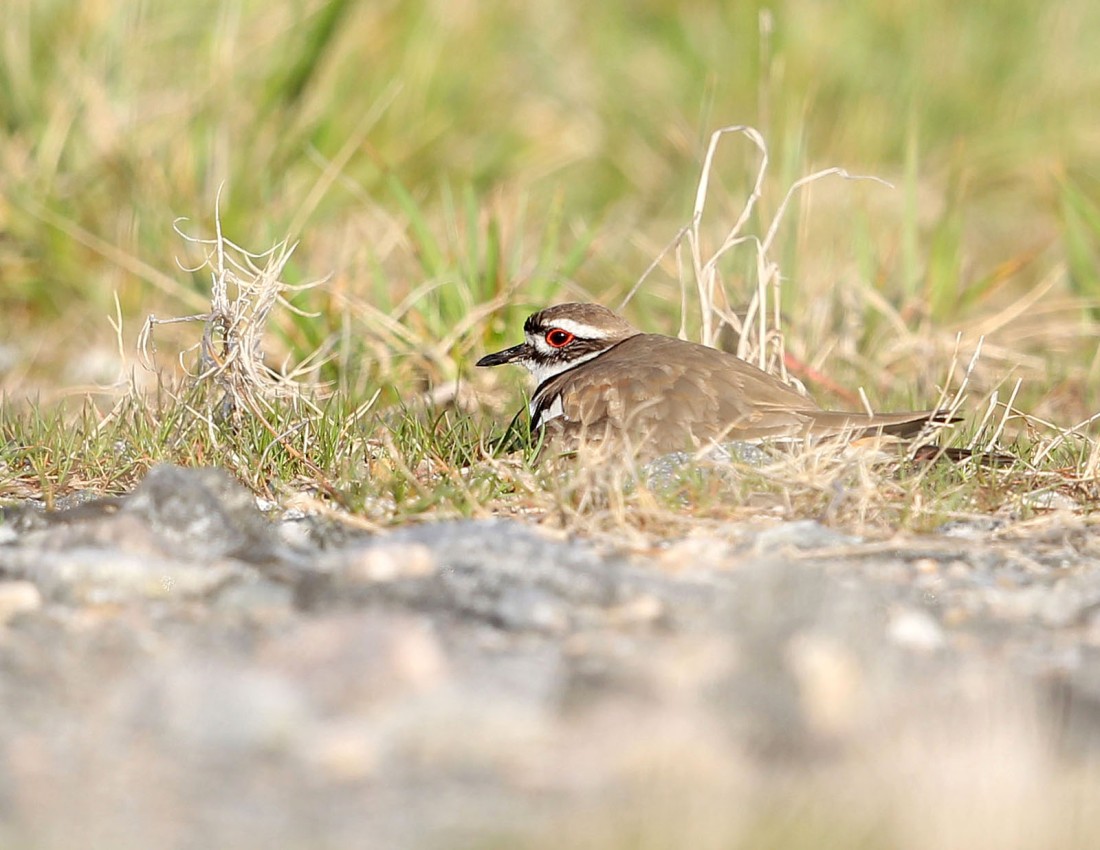
Those 4 eggs hatched right around 4/15. I wasn’t there when it happened, so this is an educated guess. I began taking pictures of the new family shortly thereafter. And I took a slew of photos on 4/19, some of which I’ve already shared. (Had I used single shot mode, I might not have taken quite so many.)
April 20
As I mentioned in “The Killdeer Saga, Part Two,” under “Mysterious Occurrence,” I arrived confidently on the morning of 4/20 to watch and take more pictures of the family. It was a lovely morning, as I recall. Cooler spring temperatures, but full sun and great golden hour lighting, which I made sure were at my back as I settled down 40-50 feet away from the birds.
I remained in that spot for about an hour. I didn’t sense any problems at all. The chicks were absorbed in the act of feeding, and their parents alternated between standing guard and feeding, themselves.

What follows is my slightly modified Facebook description of what happened next, complete with my request for help in understanding it.
After I’d been watching the birds for about an hour, and for no apparent reason, the parents decided to usher their chicks out of the preserve, under the gate, across a busy road, onto an active railroad bed, and then to a small sliver of marsh just beyond. The chicks, being introduced for the first time to the big world beyond their birthplace, had a hard time negotiating the rocks around the tracks (they occasionally stumbled and fell), and for a while couldn’t see and respond to their parents’ calls, as the tracks were too tall, and their parents were on the other side. They appeared confused and not a little bewildered. Here’s a photo that might help to illustrate. Any idea why the parents would do this?

A Request for Help
Many on Facebook responded to my request for help, and all responded well to what I like to call my “Hansel and Gretel” photo above. Several suggested that it might be best to do my observing and picture-taking from a car, and a few advised me to always wear a hat, which I usually do anyway. Someone later commented that those were great ideas as predators don’t roll, and they don’t wear hats, either. I received many good-natured comments and much helpful advice.
One person, though, responded very differently. She took me to task for “acting like a predator” and for my lack of understanding/obtuseness. She went on to say that even her kids would understand that I had provoked the Killdeer family’s departure. I and several others took issue both with her charge and with the tone of her response.
April 26
Well, I went back to the area on 4/26. The family had returned to the breeding site. I carefully moved in, and at a “safe distance” sat down and began taking pictures. In a matter of only 4 or 5 minutes, the above scene played out all over again. The parents ushered their chicks away from the breeding site, back to the railroad tracks, and back to the marshy area beyond. And I left the site now knowing the cause of their behavior and the role that my misguided fieldcraft had played. It also dawned on me that my presence (or intrusion) might have been the reason for some of those brooding episodes I’d seen (see “Parental Care”). Owning up to my responsibility and acknowledging the predator charge were pretty tough pills to swallow.
Here, by the way, is one of that morning’s captures. The arrow is pointing to a rapidly growing and developing wing.
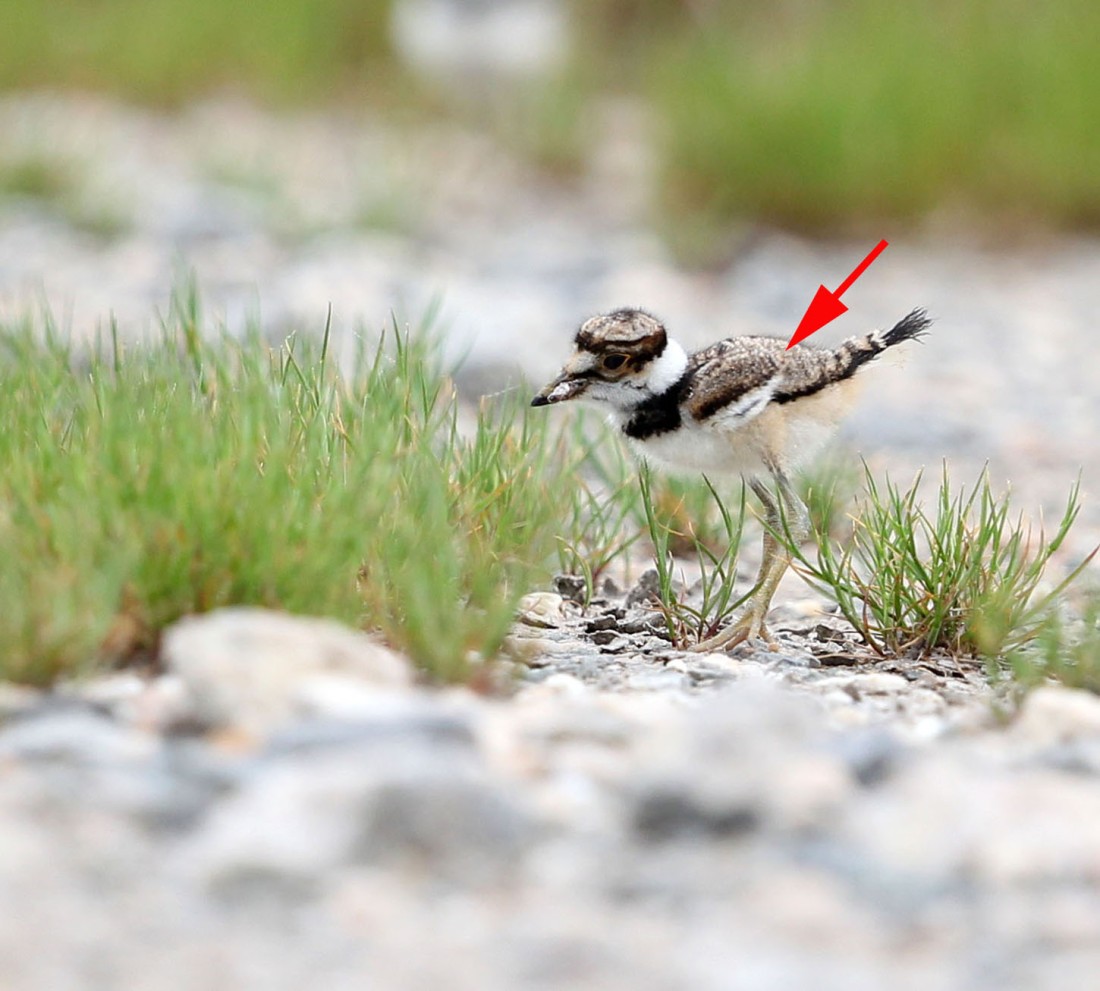
For comparison, below is one of the chicks back on 4/20, 6 days earlier. Notice its rounder look, its shorter tail (with pin feathers at the base), and its tiny, unfolded wing. My guess is that its still-developing muscles can’t quite fold that wing up.
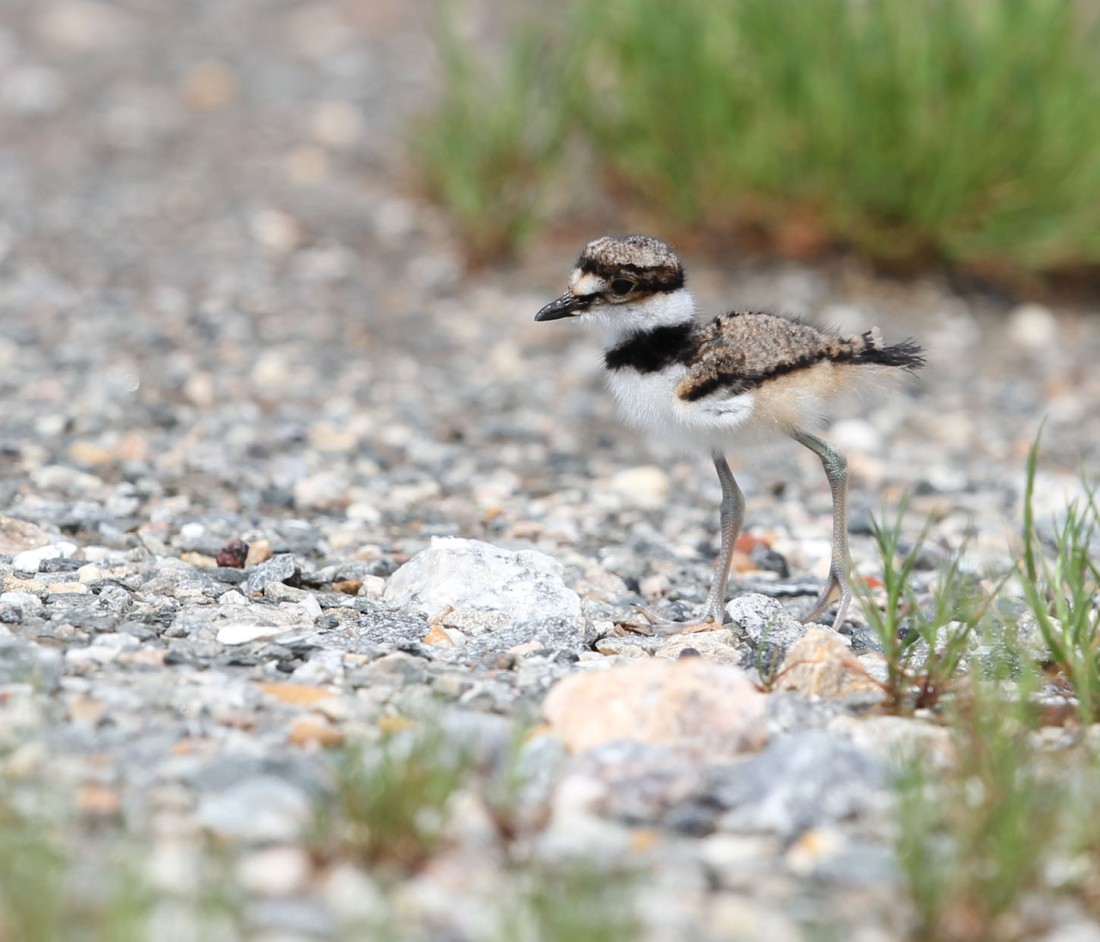
Changes
Afterward, I reflected a lot on what had happened and how I’d need to change my field tactics. I wrote the following on 5/4 after I’d visited the family once again: “Twice, I got a little too close to this family while photographing them, and twice, the parents lead their youngsters away. I learned my lesson. Today I returned, but this time I kept my distance. The parents barely took notice.” Here’s a photo I took that day (and from that greater and more comfortable distance).
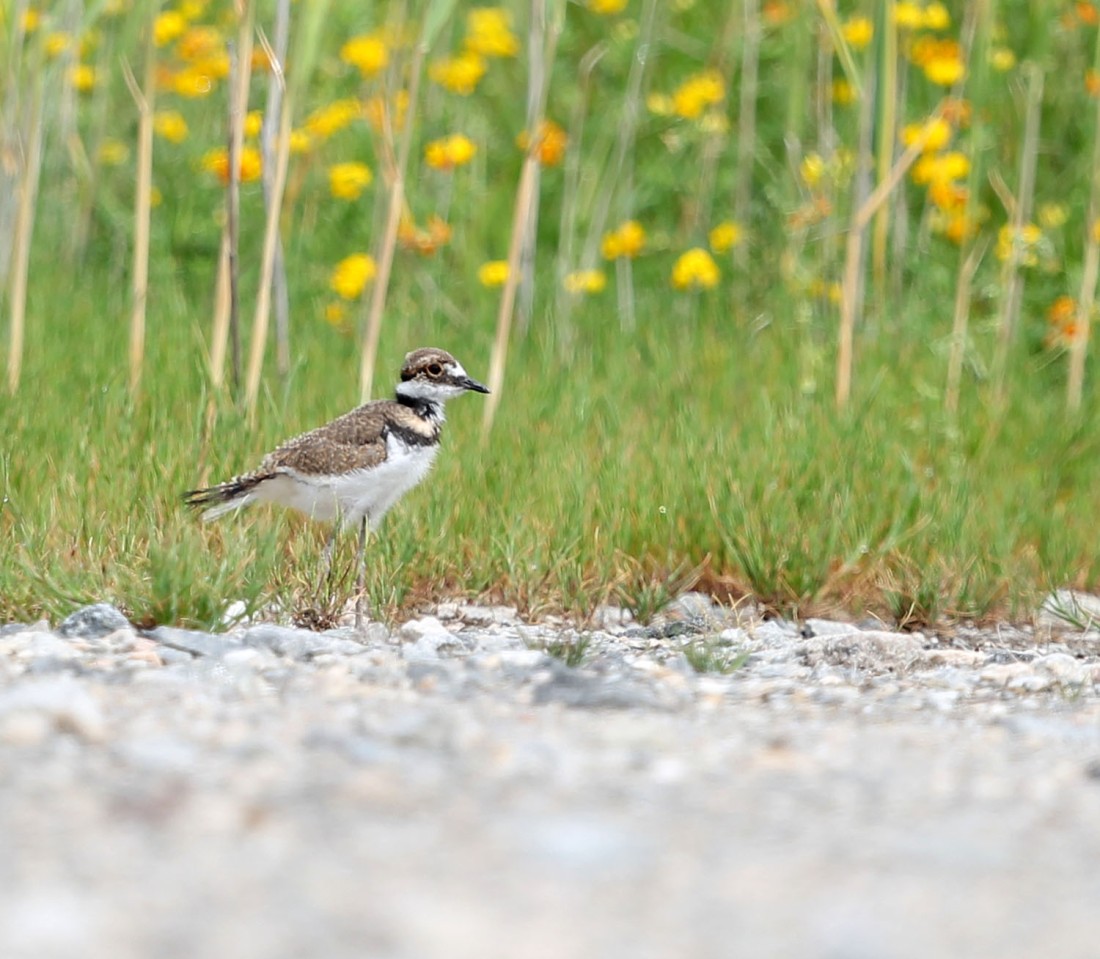
Body proportions and body shape had changed, most of the down feathers had been replaced, the wings and tail were now noticeably larger—and would soon become the main instruments of flight—and there was now an extra chest band. Something else had changed, as well.
I discovered that 2 of the chicks were missing. More trials and tribulations for the breeding pair. Even though adult Killdeer are masters of distraction displays (broken leg, false brooding, ungulate display, etc.), they still lose chicks to predation, the likely problem here.
I visited the area again on 5/15. I found the now-smaller brood and their parents back in the breeding site. I went back again on 5/18. This time they were spending their time both near the tracks and on the industrial plant property nearby. Again—typical Killdeer.
A couple of things were clear from those 2 visits: The chicks were growing fast, they were spending more time out of their parents’ line of sight, and they still couldn’t fly. This little collage I put together will give you some idea as to how fast they’d grown and how much they’d changed in about a month’s time.

A New Phase
I followed up with a visit on 5/19. I think that the family had finally vacated the breeding site. One of the parents was still guarding from a distance, but it seemed as if the family group had dispersed even further.
As I carefully approached the area near the industrial plant where the 2 chicks were feeding, they at first eyed me cautiously, but then they sprung up and flew, giving those loud, plaintive calls for which the species is named. I’d only heard “peeps” from them before. No doubt they had fledged between my visits, and a new life phase had begun. Here is a photo from that day. The plant gate, which they could now vault, is in the background.

And here is the last photo I took of the young, followed by one of the first. Two similar, characteristic, foraging poses.
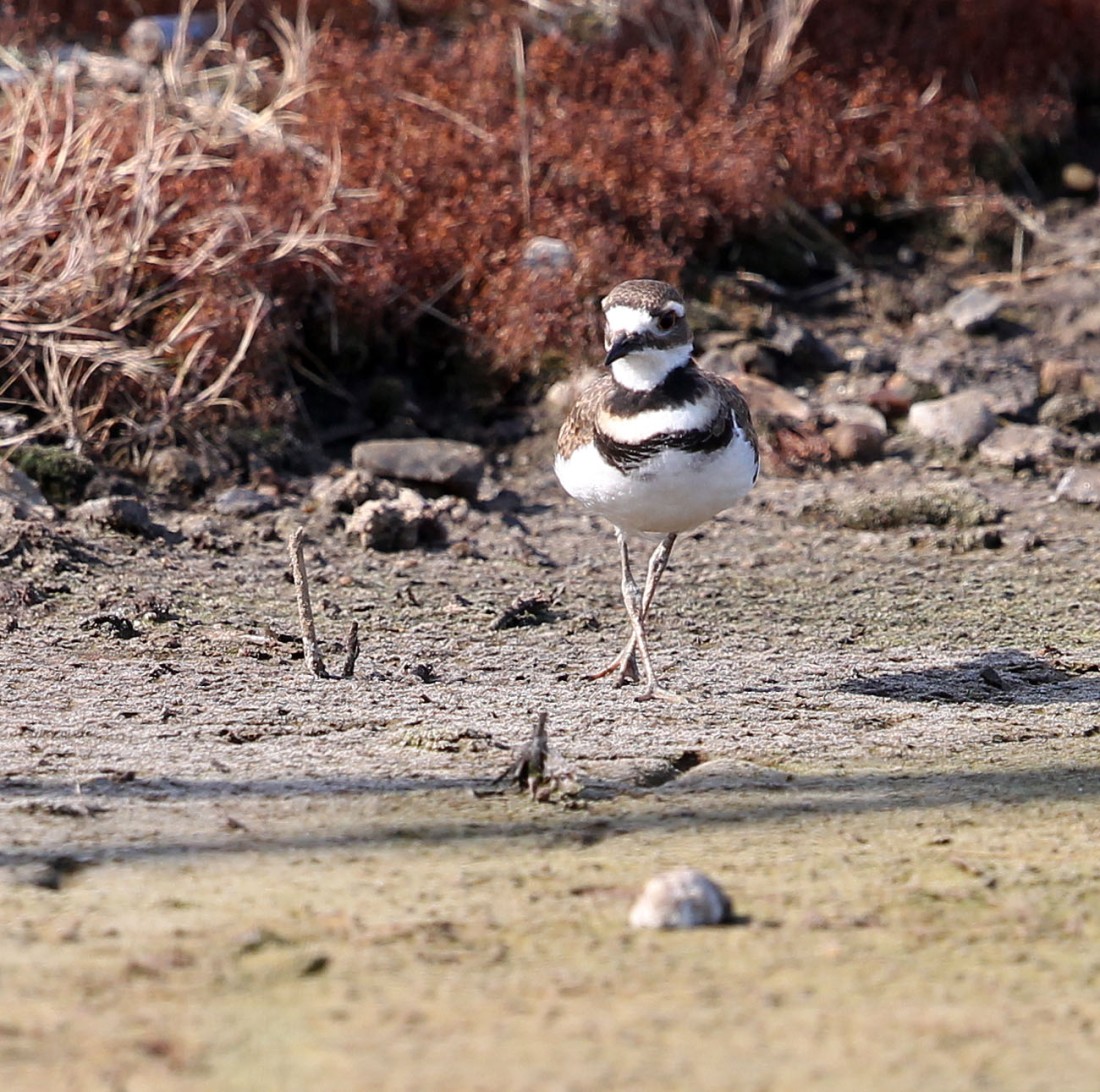
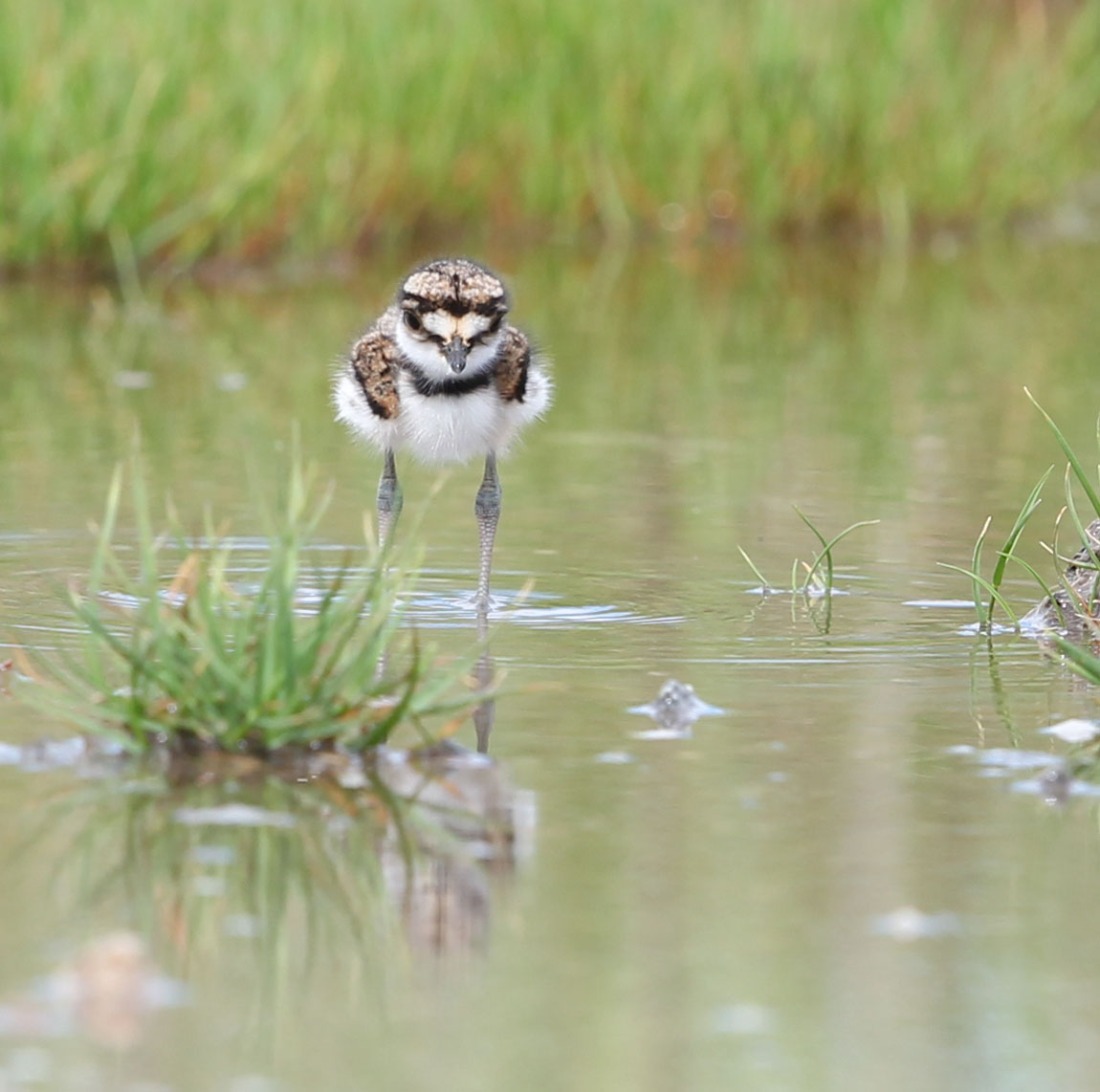
Life Cycles
I headed for home. As I drove, I remembered a message that fellow-birder, Laura Mae, had sent me about how exciting it is to witness “lovely life cycles of courting, nest building, territory defenses, and warp speed egg-to-fledge metamorphism.” A terrific line. I never witnessed the Killdeer pair courting, but I did observe pretty much everything else. What a treat and a thrill.
When I arrived home, I downed a large glass of ice water and then went to turn the radio on. Ironically—and fittingly—the first piece of music that I heard was Ralph Vaughan Williams’ “The Lark Ascending.”
And This Just In
This concludes what has now become a Killdeer saga “trilogy.” I hope you enjoyed it. Thank you, as always, for reading. And Elizabeth, thank you for reading my “Killdeer Saga” posts, and some of my other posts, to your boys. I honestly can’t think of a higher form of praise.
Quip, Question, Quote
What follows are the thoughtful and perceptive words that Karen Gieron of MD sent me after I’d sent out my “admission” on Facebook and elsewhere. They are followed by a final Killdeer photo.
“David, first, thanks for being sensitive enough to connect the dots and realize what the [Killdeer] parents were telling you. And second, thank you for sharing your ‘a-ha’ moment with us. It’s especially important during the breeding season to give even more space to nature’s families. And while we all crave to know more about the animals we share this Earth with, we aren’t being good stewards if we can’t see when our behaviors start to cross that line. Thanks again!”
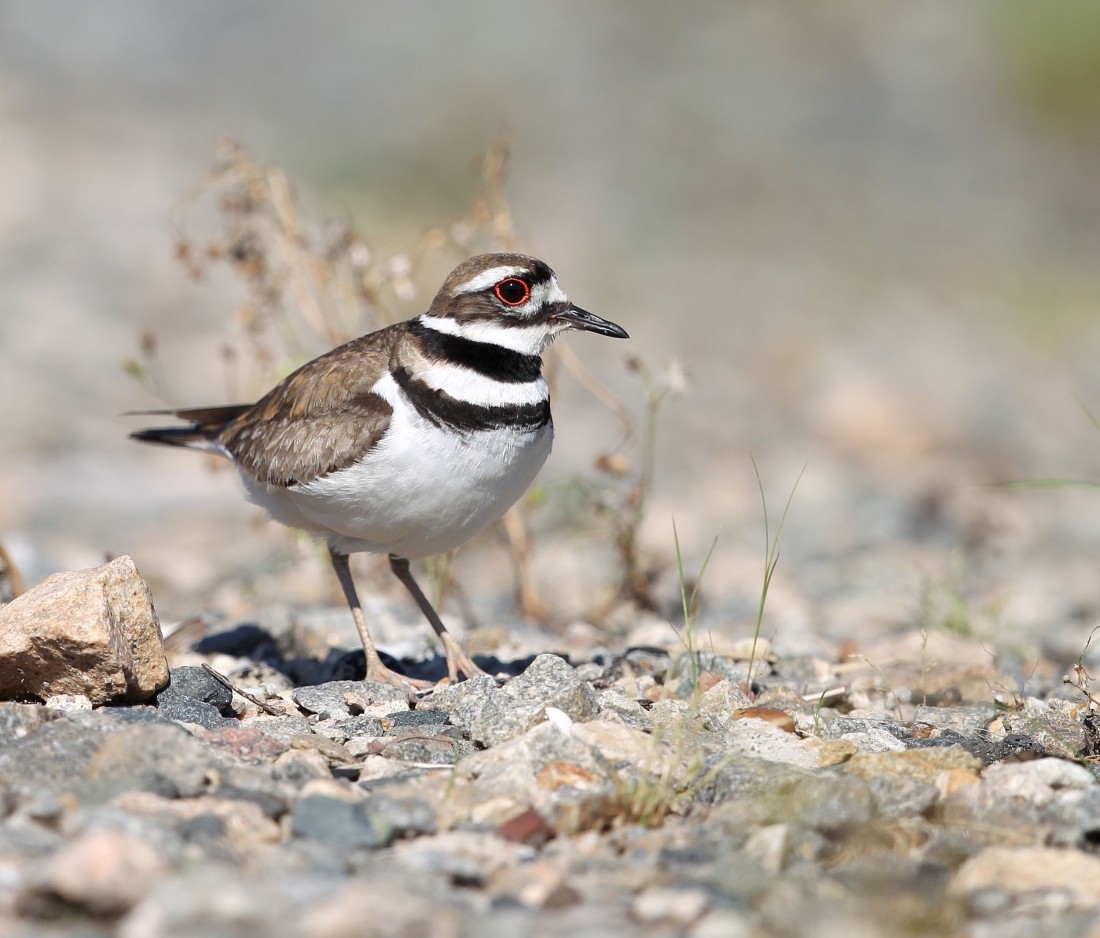
Great[ost and story, Dave. I shoot in bursts, too. You never know when that last exposure might give you a surprise. By the way, do you use a blind, or shoot from your car, or just walk to get to get close.?
LikeLike
Bob, thanks. One of things I’m learning is to shoot single shot mode more often, though I still use burst mode more. I use natural and artificial blinds when I can (stuff that’s already there), but otherwise I just shoot. I almost never shoot from my truck, though sometimes I shoot from behind it. Take care.
LikeLike
Hi David,
I didn’t have time to read your first 2 installments, but I have read this one and wanted to say that perhaps you should come down less hard upon the woman who took you to task for acting like a predator and not realizing it. Although I don’t ever try to be intentionally rude to anyone, I can understand this woman’s frustration (and thus rudeness, although I’m not condoning it) with people who are determined to get photos, see an uncommon bird, etc. I can’t tell you how many times I’ve had people tell me they were doing no harm by approaching birds closely. Just because someone knows he means no harm doesn’t mean the animals know that. Believe me, I’m pretty tired myself of trying to make folks understand this concept. You get so you just want to scream!
The fact is that birds are not stupid. You can take the tired advice to wear dull colors, such as brown or camo, and birds are still going to know you are there. As someone with a lifelong interest in nature and a lifelong intense love of the color red, I am usually wearing red in the field because it doesn’t matter what color your clothing is. For any wild animal to survive, it has to be super-aware of its surroundings, which means it can recognize a person no matter what color clothing he’s in, and a person is perceived as a predator–something many people don’t understand either.
I’m so glad you shared this story and your realization that you were indeed, the problem. I hope others will take your experience to heart and back off!
Sincerely,
Marlene
LikeLike
Marlene, Wonderful, thoughtful comment as always. Yes, watching these birds was a learning experience in many different ways—and in some unexpected ways, too. Like you said, I hope what I learned and shared here about getting too close to these birds will help others. All the best, and thanks so much for reading. And if you can manage to find the time, do take a look at those first 2 “installments.”
LikeLike
Great story.. I thought I was the only Killdeer stalker. I shoot from my car at a local cemetery, which makes it interesting when the chicks hide behind the gravestones. The pair at the cemetery chicks hatch around my birthday, so I go there days before and keep going until I finally am able to spot the wee ones in the grass. It ain’t easy..They just fascinate me. Tiny replicas of the adults. Been doing it for years! Thanks for your dtailed story. Now I need to get myself to shoot in single shot mode. haha
LikeLike
Thanks, Lynda, and thanks for sharing YOUR story. Very interesting, and I’m sure, like me, you’ve learned a lot about these birds (which really gives you a leg up when trying to photograph them).
LikeLike
Very interesting. Not surprising that a coyote may have found the first set of eggs. They are known for traveling railroads and that has even helped them expand into cities such as New York.
LikeLike
Very interesting, Kerry. Thanks, and thanks for reading.
LikeLike